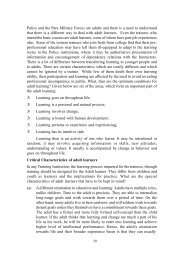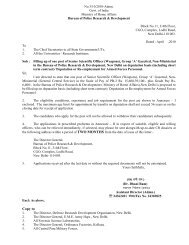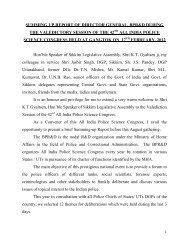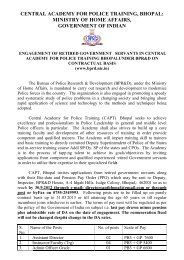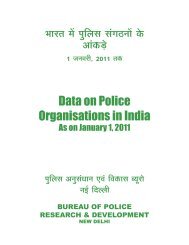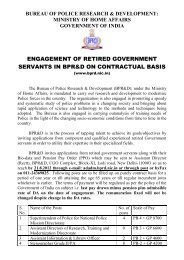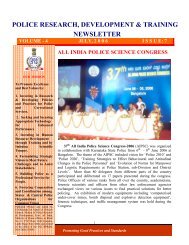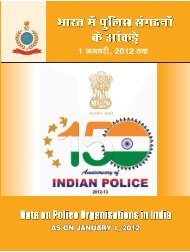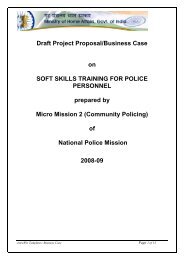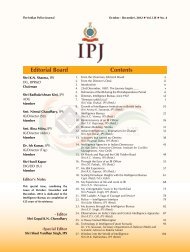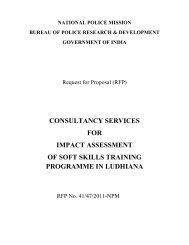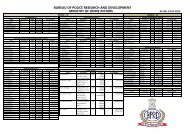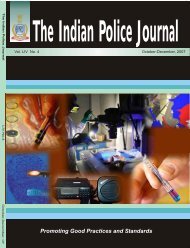April - June 2010 - Bureau of Police Research and Development
April - June 2010 - Bureau of Police Research and Development
April - June 2010 - Bureau of Police Research and Development
- No tags were found...
You also want an ePaper? Increase the reach of your titles
YUMPU automatically turns print PDFs into web optimized ePapers that Google loves.
Singapore Community Policing Experimentpolicing is linked, then, to morality <strong>and</strong> through it topatriotism. Preventing crime is what good citizensmust do, just as they must work hard, be courteous,<strong>and</strong> limit the size <strong>of</strong> their families. Crime preventionis an aspect <strong>of</strong> national ambition, <strong>and</strong> the police<strong>and</strong> the public recognize that the police make adirect contribution".AccountabilityAs the NPPs are part <strong>of</strong> the patrol branch <strong>of</strong> thepolice force, they report to the patrol comm<strong>and</strong>er asat precinct police stations when they carry out crimeprevention duties or interact with the community.NPPs have also improved substantially thewillingness <strong>of</strong> the public to report matters to thepolice. Reports from the public have increased from12 per cent to 56 per cent in areas where NPPs havebeen established 6 . It is also very gratifying that closelinks with community organizations have not bredcorruption in the police or resulted in the unequalenforcement in the law.TrainingCommunity policing requires new forms <strong>of</strong>training. For community policing to worksuccessfully, Singapore police felt that allpersonnel have to be properly trained. Every onemust know the nature <strong>of</strong> duties to be performedby the police in community policing. This had theeffect in preventing any growth <strong>of</strong> gulf betweenthose in the new program <strong>and</strong> <strong>of</strong>ficers assignedto customer duties. This also created a receptiveclimate for it within the force. Singapore policealso use evaluation as a tool for persuading peopleto opt in favour <strong>of</strong> community policing. The newpolice techniques were evidence based.Evidences were collected about the pilot projectbefore a decision was taken to make communitypolicing an operational strategy. Communitypolicing was not however, used to challenge the6 Singapore <strong>Police</strong> Evaluation Reports on NPP, 1984.7 David H. Bayley: <strong>Research</strong> Report - A Model <strong>of</strong> CommunityPolicing: The Singapore Storyposition <strong>of</strong> politicians. Politicians were allowedto take full credit for the initiatives launched bythe police. The police "strove for a cooperativerather than a competitive relationship with thelocal politicians 7 ".Problem SolvingThe NPP system <strong>of</strong> community policing served theSingapore <strong>Police</strong> Force (SPF) well from 1983 to1997. The SPF undertook a survey <strong>of</strong> its operationalstrategy <strong>and</strong> realize that future would not be builtthrough perfecting the past, though it had been quitesuccessful. There is a need for innovation to meetnew policing challenges <strong>and</strong> public needs.Community policing has also been refinedincrementally in Singapore. <strong>Police</strong> now seek toplay problem-solving role <strong>and</strong> endeavour forresolution <strong>of</strong> certain community law <strong>and</strong> orderproblems that emerged from systemic causes. Thisproactive problem-solving approach establishesstronger bonds between the police <strong>and</strong> thecommunity.An example <strong>of</strong> a good problem-solving case isthat by Hong Kah, South NPP. The NPP used toreceive complaints about the c<strong>of</strong>fee-shopvisitors drinking after mid-night when c<strong>of</strong>feeshops were closed. Their unruly behaviourcaused public unease <strong>and</strong> frustration. NPP<strong>of</strong>ficers, instead <strong>of</strong> merely taking action againstthe lawbreakers, sought the cooperation <strong>of</strong> theowners <strong>of</strong> the c<strong>of</strong>fee shops to stop the sale <strong>of</strong>the beer half-an-hour before the end <strong>of</strong> thestipulated licensing time; to stack up the chairs<strong>and</strong> chain them up before closing the c<strong>of</strong>feeshops; <strong>and</strong> remove all empty bottles from thetables to prevent their use as weapons. Thepolice also exerted peer group pressure on theowners <strong>of</strong> problematic c<strong>of</strong>fee shops. They wereasked to follow the good practices <strong>of</strong> theircounterparts. The above measures weresuccessful in curbing the problems <strong>and</strong> theresidents <strong>of</strong> the area now enjoy restful nights.model <strong>and</strong> broughtabout a completeconversion <strong>of</strong> thesystem between theyears 1983 to 1989.All these changes weremade within a shortperiod <strong>of</strong> time <strong>and</strong>without expenditure <strong>of</strong>resources beyond thenormal budget.The Indian <strong>Police</strong> Journal Vol. LVII-No. 2, <strong>April</strong>-<strong>June</strong>, <strong>2010</strong> 15➢



